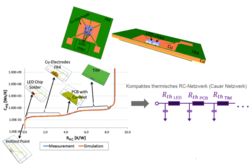Thermal transient simulation, in combination with experimental thermal impedance analysis, and the use of the so-called structure function enables deeper understanding of the thermal behavior of microelectronics components. The structure function is a mapping of the heat path from heat source to heat sink in the form of thermal resistances and capacities. Comparison of simulated and measured structure function constitutes an advanced tool for validation of the simulation and the interpretation of the experiment. By this means improvement of the thermal management of microelectronics by “Virtual Prototyping” is enabled [1].
In this way we e.g. develop special PCB concepts including high thermal conductive but electrical insulating ceramic coatings at critical points within the system. Analyzed compact thermal models in addition can improve the “Condition Monitoring” and “Structural Health Monitoring” of components. This is considered as an innovative and cost effective method for “Predictive Maintenance” e.g. in lighting industry.



















